Venting Your Dryer Into the Garage? Think Again!
Author: Omar Alonso | Editor: Omar Alonso
Review & Research: Jen Worst & Chris Miller

Where does your dryer vent to? You'll want to read this post if you're venting your dryer into your garage. This can be dangerous, and you're placing your property at a fire and health risk. There are plenty of other safer options for venting your dryer.
Mold growth, allergy reactions, and toxic fumes are all potential dangers to your home and health. Venting your dryer outdoors is a much better idea to remove the risk. Let's unpack the risks of running your dryer vent into the garage and discuss other safer strategies.
Reasons for Venting Your Dryer Into the Garage
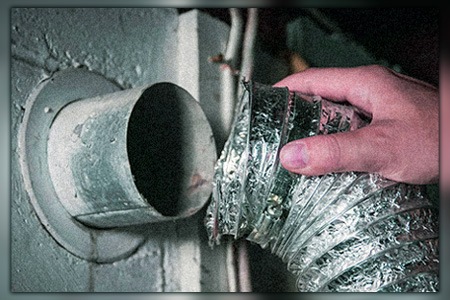
Every clothes dryer needs a vent, it's a critical component of the system, and you need to account for it when setting the appliance up in your home. The dryer's function is to bring heated air into the drum, removing the humidity to dry your clothes. It needs a vent to push out the hot, humid air to achieve that function.
Dryers don't just circulate hot air; they draw fresh air to the drum and push out humidity. The vent transfers the humid, hot air out and away from the dryer drum. The dryer has three core functions.
- It provides hot air to the drum to heat the clothes
- It removes moisture from the drum to dry the clothes without shrinking them
- It vents the hot, humid air outside of the unit
So, venting the dryer is essential to ensure proper appliance function. However, many homeowners want to avoid the hassle of drilling and cutting holes to fit the ducting from the vent outlet to the home's exterior.
It takes expertise and a budget to install ducting correctly, and homeowners might want to avoid absorbing these costs. Many homeowners feel it's fine to set the appliance up in the garage and let it vent into the space. However, this practice might be a terrible mistake, even if you have superior garage ventilations options in play exhausting the dryer air out of your garage.
What are the Hazards of Venting a Dryer into Your Garage?
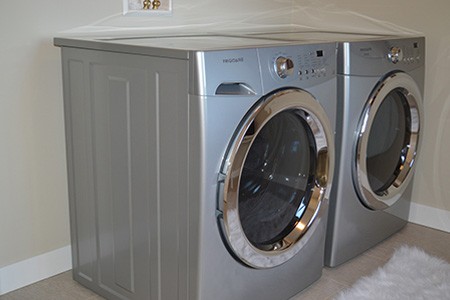
Can you vent a dryer into a garage? You can and might get away with it for a while without any immediate issues, but you'll be creating hazardous conditions that can then affect the rest of your home.
Dryers are great for wet or cold climates where you can't dry clothes outdoors effectively. The dryer allows fast drying of clothes, and some people in warmer regions may prefer its efficient operation instead of using a traditional clothes hanger.
While the dryer is an effective and convenient appliance, it also requires a correct operation. Venting the dryer into the garage is not a good idea for several reasons. This is why you never see a garage dryer vent built into a home and why it's always a modification.
First, the heat from the dryer vent is much warmer than expected. If you direct the vent against combustible materials, like insulation, you risk burning the house down. The heat applied to a surface accumulates and steadily builds to a tipping point when it causes the conflagration and ignition of the materials, leading to a fire.
A squeaky dryer is often ignored, but if it's generating smoke and being vented into the garage, you could not only inhale that in the garage but you wouldn't realize there's a much more serious or dangerous issue going on inside of the dryer.
Secondly, venting the hot, humid air from the dryer into the garage presents the perfect environment for the rapid growth of toxic mold and mildew. The spores from these pathogens will spread into your home and contaminate the air. Mold infestation is challenging to spot for the untrained eye. You'll notice the presence of mold by the way it affects your health.
If you have mold in the home, you'll identify it through health symptoms like increased allergy reaction. Respiratory problems and rashes appear on the skin. You might also notice you have itchy, watery eyes. Mold infestations often require professional removal, which can become an expensive problem.
The third problem with venting into the garage comes from gas-powered dryers. These machines release fumes along with warm air. They can build up in the garage and spread into the home. As a result, you put yourself at risk of carbon monoxide poisoning. It's like running your car in the garage with the door closed.
Any gas-powered dryer requires the fitment of correct venting systems, flues, and a carbon monoxide detector in the laundry room. These machines are usually not found in residential homes and are mainly used in commercial settings.
That begs the question, "is electric dryer exhaust harmful?" While I wouldn't recommend breathing in directly, it technically should only contain hot air with trace amounts of detergent and fabric cleaner and other deodorizing products used in your washing machine. Any normal exposure you would have to it in the laundry room while venting it outdoors is safe for you. You should not vent it into your garage or any other part of your home, still.
Why You Should Avoid Venting the Dryer Into the Garage
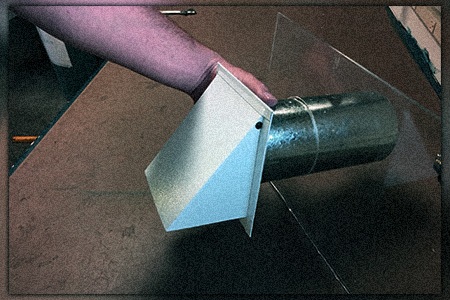
Dryers release lint with the air they expel from the appliance's exhaust vent. The lint will eject into the garage, building up over time. Since most people don't prioritize cleaning the garage, they'll develop a problem with lint buildup in the area.
Creating a warm space in the garage is a bad idea. It's just like venting a bathroom fan into an attic and sending heat and humidity in there. It attracts mold and pests to the room.
Rats and other vermin, bats, snakes, spiders, and raccoons will detect the heat emanating from the garage and move in, much to your dismay. You might not notice these pests setting up residence in your garage at first. After a few months, you see signs of rodents in your home or cobwebs everywhere.
Venting the dryer into rooms in the home, like the garage or the front screened porch, will be against building and health codes. Still people will vent a dryer in the middle of the house and ignore these precautions. If you're selling the house, your dryer vent needs to be in the right position to receive approval and certification from an inspector.
Where Should I Vent My Dryer Then?
Homeowners should vent their dryers outside the home. Setting up the ventilation system is challenging, and homeowners need handy and technical skills for its effective fitment. So, your only other choice is to call a professional who knows what they're doing.
The handyman or professional service company will install the venting using the right tools and materials. They'll build the ducting system using the right size ducting, expelling it out of the exterior wall where it doesn't cause harm or health risk to your property or family.
Cleaning the Dryer Ventilation System
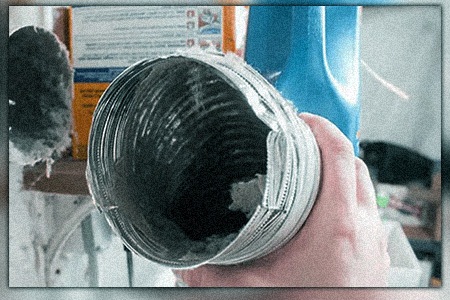
Homeowners also make the mistake of thinking they don't need to maintain their dryer ventilation system. As a result, the lint builds up in the ducting, causing blockages. A blocked dryer ventilation system is as dangerous as venting the dryer into your garage.
Blockages cause heat to back up in the ventilation system and may damage the appliance. It also presents heat accumulation in the system resulting in a fire risk. Homeowners should clean the ventilation system at least every other month, and they can complete this task themselves or hire a professional to do the job.
Dryer Ventilation Maintenance Tips
Follow this procedure for effective maintenance of the dryer's ventilation system.
- Unplug the appliance's power supply
- Pull the dryer a few inches away from the wall to access the rear of the machine
- Remove the ducting from the vent exhaust outlet. Most models secure the ducting to the ventilation exhaust port using a circular clamp you can undo with a screwdriver or wrench
- Use a vacuum cleaner and push it inside the vent to remove as much lint as possible
- Clean the floor around the dryer and collect all lint
- Reattach the ducting to the exhaust port and secure it with the clamp
- Check the ducting for damage or cracks
- Reposition the dryer correctly
- Go to the exterior vent and remove the cover
- Vacuum the lint inside the ducting as best as possible and replace the cover
- Plug it back in and turn the power supply back on
You need to keep your dryer vent clean and clear from excess lint not only due to fire hazards but to keep your dryer from overheating. If it can't exhaust heat like it's designed to, you can decrease the expected lifetime of your expensive appliance, too.
Are There Laws Preventing Venting a Dryer Into Your Garage?
All dryer vents are subject to specific building codes. Violating the regulations adversely affects the outcome of a home inspection when you sell the property. If you vent the dryer into the garage or the laundry room and leave it in the home during the check, the inspector will note that in their report.
Likewise, if you create vent ducting systems and fit them incorrectly, the installation will fail the report. The venting exhaust panel and all types of roof vents must have specific clearances from the roof. The structure and design of the venting system are also critical for receiving approval and certification from inspectors.
What are the Design Standards for Dryer Ventilation Systems
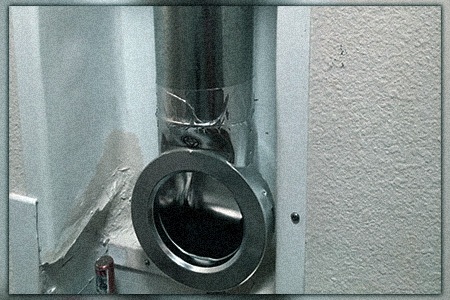
A properly installed ducting system should feature design and construction using rigid metal ducting. Using plastic ducting presents the threat of the material melting under high temperatures. The dryer ducting system should feature materials measuring a minimum of 0.016" thickness and be free of obstructions and kinks and obstructions.
The ducting system must be connected tightly with sealed joints, and there must be no leaks from the ventilation system. The dryer vent should be as straight as possible and at most 35 feet long. Some homeowners might need to build the venting system around obstacles. In this case, the ventilation system will need a 2.5-foot reduction for every 45-degree turn and a 5-foot decrease for every 90-degree turn.
Awkward bends and vertical runs must have the appropriate cleanout system installed to remove lint buildup. The system must be easy to remove and service. Dryer vents must be vented to an exterior wall with a minimum clearance of 12" from the ground. The system must also include a backdraft arrestor for safety.
Venting a Dryer Into a Garage? Bad Idea!
Some of the key takeaways of this article are that you shouldn't vent the dryer into your garage. It presents fire and health risks to your property and family. You should install ducting correctly according to the design specifications and code regulations while regularly maintaining the ducting to avoid lint buildup. Venting a dryer into a garage is not a good idea.



